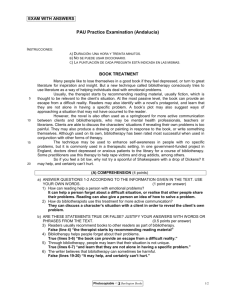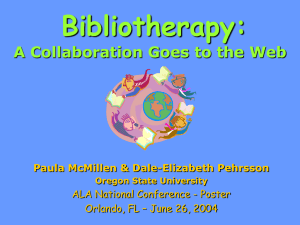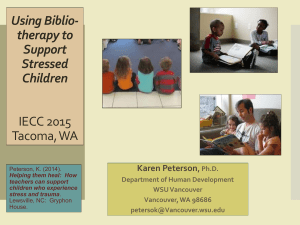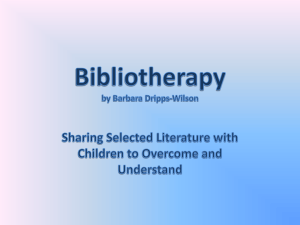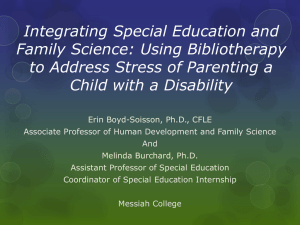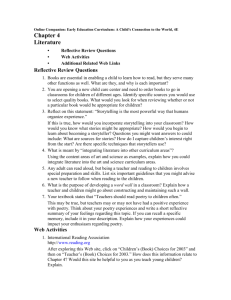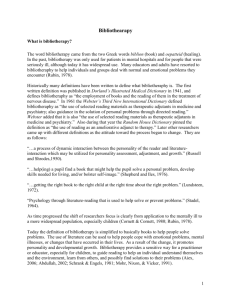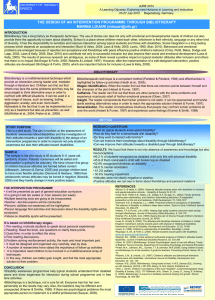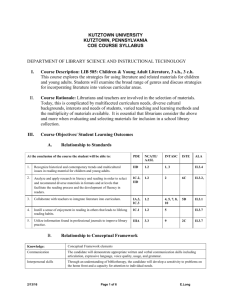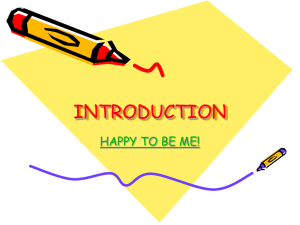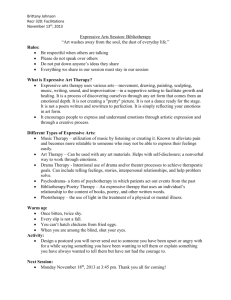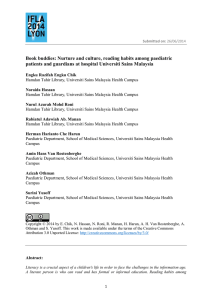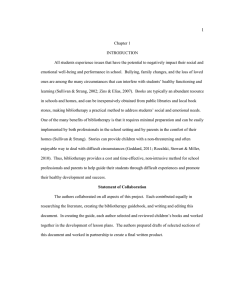Bibliotherapy Power Point
advertisement
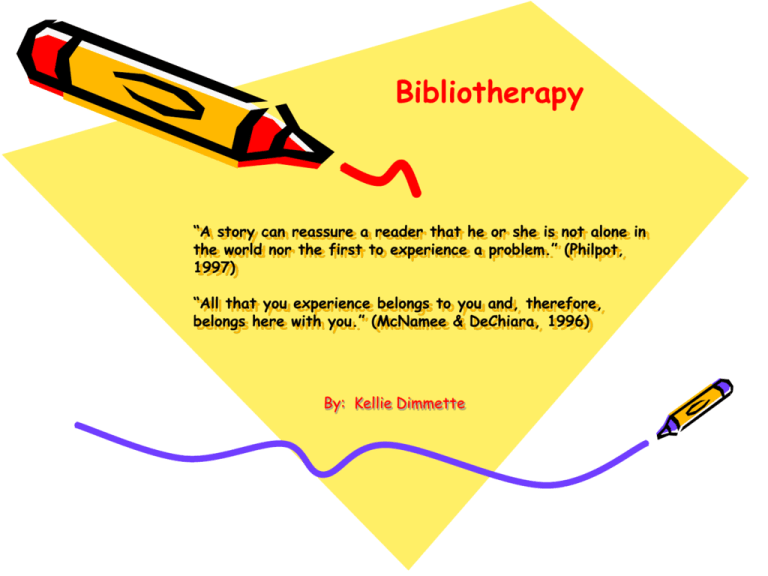
Bibliotherapy “A story can reassure a reader that he or she is not alone in the world nor the first to experience a problem.” (Philpot, 1997) “All that you experience belongs to you and, therefore, belongs here with you.” (McNamee & DeChiara, 1996) By: Kellie Dimmette Definitions from the Past • In 1961 the Webster’s Third New International Dictionary defined bibliotheraphy as “the use of selected reading materials as therapeutic adjutants in medicine and psychiatry; also guidance in the solution of personal problems through directed reading.” • Random House Dictionary pinned the definition as “the use of reading as an ameliorative adjunct to therapy.” Other Researchers: • “…a process of dynamic interaction between the personality of the reader and literature-interaction which may be utilized for personality assessment, adjustment, and growth.” (Russell and Shrodes, 1950). • “…help(ing) a pupil find a book that might help the pupil solve a personal problem, develop skills needed for living, and/or bolster self-image.” (Shepherd and Iles, 1976). • “…getting the right book to the right child at the right time about the right problem.” (Lundsteen, 1972). • “Psychology through literature-reading that is used to help solve or prevent problems.” (Stadel, 1964). (Cornett & Cornett, 1980; Rubin, 1978) What Bibliotherapy Means Today • Today the definition of bibliotherapy is simplified to basically books to help people solve problems. • The use of literature can be used to help people cope with emotional problems, mental illnesses, or changes that have occurred in their lives. As a result of the change it promotes personality and developmental growth. Bibliotherapy provides a sensitive way for a practitioner or educator, especially for children, to guide reading to help an individual understand themselves and the environment, learn from others, and possibly find solutions to their problems. (Aiex, 2006; Abdullah, 2002; Schrank & Engels, 1981; Mohr, Nixon, & Vicker, 1991) Positive Effects of Bibliothearpy: Socially • • • • • • Meets Needs: Psysiological Safety Love and Belonging Esteem Knowledge & Understanding Reassures the reader that they are not alone in the world or the first to experience a particular problem. Provides a model for coping with problems and forming possible solutions. Prepares children for living and “experience” of emotions and situations they have not faced. Helps students accept people that are different from themselves. Assists with the development of interpersonal relationships and values. Positive Effects of Bibliothearpy: Academically • Promotes reading achievement. • Motivates students to read. • Students gain a richer insight and meaning of a story. • Avenue to developing a love for literature and reading. Negative Effects of Bibliotherapy • The treatment should not be used as a single approach for a severe need. • The child may not be a good reader so the process becomes a turn-off. • Student may not be willing to read the story or book. • A projection of the child’s own motives may be placed on the characters; therefore it reinforces their own perceptions and conclusions, which may be negative. • The child may be unwilling to discuss areas that are uncomfortable. Bibliotherapy Lesson: We are all alike…We are all different… • • Your first decision when preparing a lesson is to decide whether you want to use an individual or group approach. Group approach has more advantages: -less time-consuming. -more natural for the children. -enhances the child by allowing them to share common experiences. -less anxiety -better sense of belonging and security -everyone is able to develop different perspectives and new understandings of the problem. Setting of the Lesson • “Break the Ice” Activity “Me in a Nutshell” • Positive Atmosphere Activity: Comparing Eggs • Pre-Discussion of the story What things in the story may be alike and what things may be different? Comparing Eggs Activity Through an experiment with two eggs, one white and one brown, children will create awareness of the similarities and differences among people. Materials: One brown egg, One white egg, and a bowl Plan: Following a discussion with the children about how people are alike (We all have two eyes and hair) and how we differ (blue eyes vs. brown eyes, long hair vs. short hair). Break each egg into the bowl and dispose of the shells. Reflection: Can the students tell which is which? No, because just like people even though we may look different on the outside, we are all the same on the inside. Read Story All the Colors of the Earth • Stop on each page to discuss the children’s similarities and differences with the children listening to the story. Post-Reading Discussion • • • • • • • How did the children in the story look? What emotions did you see? Why is it important to talk about people that are different from us? Have you ever seen anyone or have you ever been mistreated because you are different? How do you think this person felt or how did you feel? How can we solve this problem? Why should everyone be treated equally? Follow-Up Activities • Mirror, Mirror • Writing Activity: Creating a class book about families. • Extension: “A Project About My Family” Mirror, Mirror Through an activity about observing the students in a mirror they will draw and color themselves how they are. Materials: Mirror, paper, yarn, glue, crayons. Plan: Encourage the students to look in their mirrors to find out their color of eyes and hair. The students will look at themselves in the mirror with every detail; they will draw their faces with the color of their eyes and hair, and the style of their hair. Reflections: What makes you special or unique? The students will pair with another student and discuss their physical differences. Discuss and encourage the students to discover that everyone is different; however some of us have similarities. Writing Activity: Creating a class book about families Children will create their own class book. We are all alike…We are all different… Children will write about their families. They will answer the questions and share them with their peers. Children will write about their feelings. When I am happy I… When I am sad I… When I am upset I… When I am scared I… Extension: “A Project About My Family” Through this activity the students will find out that everybody has a family but there are differences among them. Materials: A hand out with some questions about themselves and their families: What is your favorite food? What is your favorite game? How many members are in your family? Where are you parents from? Where do you live? What is the favorite activity to do with the family? Discussions: Each student can do a simple presentation about themselves and their families. Discuss the similarities and differences among the students. Additional Activities • What color is your skin? • Everybody shows their feelings in a different way. • Math Extension Activity • Art Extension Activity What color is your skin? Through this activity the students will discover the color of their skin, and learn we are a mixture of colors. Materials: Paint Plan: With a partner the students will mix paints until they find the exact color of their skin or the teacher can do this for each student. Reflection: The students will discuss the different colors of their skin. Does the color of our skin make us different from our friends? Everybody shows their feelings in a different way Plan: Discuss with the students the different ways they show their feelings (happy, sad, upset, scared). Discussions: Respect the way people show their feelings. We need to respect different feelings and be tolerant with others. Math Extension Activity Children will use graphs with their characteristics. • Color of their eyes. • Color of their hair. • How many members are in their family. Art Extension Activity Students will design their own self-portrait References • Abdullah, Mardziah Hayati. (2002). Bibliotherapy. ERIC Digest, 1-6. • Aiex, Nola Kortner, Bibliotherapy. (2006) Retrieved February 2006, From http://www.ldonline.org/ld_store/bibliotherapy/eric_digest82.html. • Bibliotherapy. (2006). Retrieved February 2006, From http://maxweber.hunter.cuny.edu/pub/eres/EDSPC715_MCINTYRE/Biblio.html. • Campbell, Laura A. (1999). Storybooks for Tough Times, Colorado: Fulcrum Publishing. • Cornett, Claudia E. & Cornett, Charles F. (1980). Bibliotherapy: The right book at the right time, Bloomington, Indiana: Phi Delta Kappa Educational Foundation. • Jackson, Shelley A. & Nelson, Kaye W. (2001). Use of children’s literature in a comprehensive school guidance program for young children. CEDER Yearbook, 2-20. • Joshua, Janice Maidman & DiMenna, Donna. (2000). Read two books and let’s talk next week, New York, Chichester, Weinheim, Brisbane, Singapore, Toronto: John Wiley & Sons, Inc. • McNamee, Abigail & DeChiara, Edith. (1996). Inviting stories to help young people cope with stressful life experiences. Classroom Use Teaching Guide, 1-31. • Moody, Mildred T. & Limper, Hilda K. (1971). Bibliotherapy: Methods and materials, Chicago: American Library Association. References Continued • Mohr, Carolyn, Nixon, Dorothy, & Vickers, Shirley. (1991). Books that heal: A whole language approach, Englewood, Colorado: Teacher Ideas Press. • Philpot, Jan Grubb. (1997). Bibliotheraphy for classroom use, Nashville, TN: Incentive Publications, Inc. • Rubin, Rhea Joyce. (1978). Using bibliotherapy: A guide to theory and practice, Phoeniz, AZ: Oryz Press. • Schrank, Frederick A. & Engels, Dennis W. (1981). Bibliotherapy as a counseling adjunct: Research findings. The Personal and Guidance Journal, 143-147. • Sridhar, Dheepa & Vaughn, Sharon (2000). Bibliotherapy for all: Enhancing reading comprehension, self-concept, and behavior. The Council for Exceptional Children, 33 (2), 74-82.
